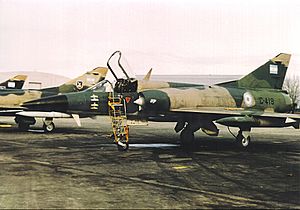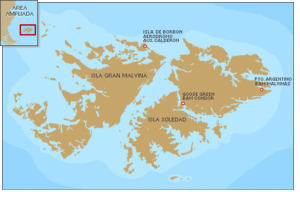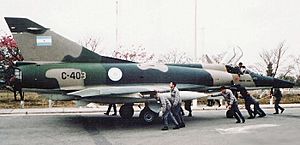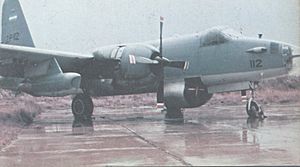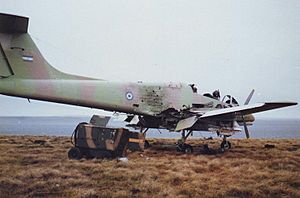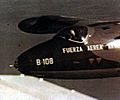Argentine air forces in the Falklands War facts for kids
This article is about the planes and pilots of Argentina who fought in the Falklands War (also called Guerra de las Malvinas in Spanish). It covers the planes and people from the Air Force, Army, Navy, and other groups.
To learn about the air forces of the United Kingdom, you can check out British air services in the Falklands War.
Contents
Argentina's Air Power in the Falklands War
Why Argentina Wasn't Ready for Air Combat
When the war started, Argentina's government had not planned how to defend the islands. They thought taking the Falklands would lead to talks, not a big fight. So, they were surprised when Britain sent a large group of ships and planes to take the islands back.
The Argentine Air Force (FAA) had never fought a major war against another country since it was created in 1912. It wasn't trained or equipped for a long-distance air battle over the sea against a powerful group like NATO. For example, the FAA had only two refueling planes for its entire air force and navy. Its fighter-bombers, like the Mirage III and IAI Dagger jets, couldn't refuel in the air. The FAA's training and equipment were mostly for a possible war against Chile.
During the war, Argentina was worried about Chile. Chile's military had many forces near the border. This made Argentina bring back old F-86 Sabre planes to help defend its skies. However, Peru quickly offered help, even offering to fly combat missions, but Argentina politely said no. As the war went on, Peru and Venezuela sent important aircraft parts that Argentina needed. The Brazilian Air Force also lent two EMB111 Bandeirantes planes to the Argentine Navy for sea patrols. Later, ten Peruvian Mirage 5 jets arrived, but the war ended before they could be used.
Argentina had about 240 planes when the war began. About half of these were kept inland or near the Chilean border. The long distances from their bases meant planes couldn't fly at top speed for long, or they would run out of fuel. Even though Argentina had more planes than the British, many were slower Pucara propeller planes. Also, the A-4 Skyhawk jets relied on only two KC-130 refueling planes, which limited how many could attack at once.
Argentina's A-4 Skyhawk attack jets were in poor condition. An arms ban from the United States in 1976 had made many planes unusable. It's believed that Israel helped get these A-4s ready for action, but this has never been fully confirmed.
The small air branch of the Argentine Navy (ARA) was changing from A-4Q Skyhawks to newer Super Etendard jets. Only five of the Etendard's special Exocet anti-ship missiles had arrived when the war started. An arms ban stopped more from being delivered. Also, French engineers had not finished programming the missiles to work with the Etendard's computers. When the war began, France, being a British ally, called back its engineers. This left Argentine scientists to figure out how to make the missiles work.
Navy pilots, especially those flying A-4Qs, were the only ones trained to bomb warships. Air Force pilots practiced in April against two Argentine destroyers, which were similar to British ships. Naval officers said all the practice attacks were "shot down," which worried the commanders. But successful attacks in May showed that aircraft could survive.
Argentine military aviation had never been in an international conflict before. The last time the Argentine military fought in an international war was over a century ago.
Despite these challenges, Argentine air units did most of the fighting during the six-week war. They caused serious damage and losses to the British naval forces. Low-flying jets attacking British ships created some of the most dramatic moments of the war. By the end of the conflict, British forces admired the FAA's brave actions against a strong air defense. Admiral Sandy Woodward, the British Task Force commander, said: "The Argentine Air Force fought extremely well and we felt a great admiration for what they did."
A British report released in 2013 stated that Argentine air forces fought for 10 weeks. They supplied their troops, scouted British forces, and attacked British ships. Even though they lost many planes, their air forces were not defeated and could still fight at the end of the war. The report noted that the Argentine air groups were generally skilled and well-organized, but they lacked enough refueling and scouting planes. A shortage of spare parts might also have limited their effectiveness. The report concluded that Argentina's air forces successfully supplied their troops, were partly successful in scouting, and caused significant damage to British naval forces. However, they did not achieve major success against British ground forces on the islands.
How Argentina's Air Forces Were Organized
The air units in the Falklands War followed a clear chain of command:
- Military Junta – Led by Brigadier General Basilio Lami Dozo. This was the top military group.
- Air Defence Command (Comando Aéreo de Defensa) – Brigadier Jorge Hughes was in charge. This group managed radars, Mirage IIIEA interceptor jets, and anti-aircraft defenses on the mainland.
- Strategic Air Command (Comando Aéreo Estratégico) - Brigadier Helmuth Weber. This command coordinated all air forces across the country. It also handled long-range sea patrols with Boeing 707s and C-130 Hercules planes.
- Southern Air Force (Fuerza Aérea Sur) – Brigadier Ernesto Crespo. This was the main group fighting over the Falkland Islands.
- South Atlantic Military Theatre (Teatro Operaciones Atlantico Sur) - Vice Admiral Juan Lombardo. This was mainly a naval command. It coordinated air, sea, and submarine forces in the South Atlantic. It was first thought to be the only group needed to manage the situation during the invasion of the islands on April 2.
- Falklands Military Garrison (Guarnicion Militar Malvinas) - Brigade General Mario Menéndez (Army). This was the army group on the islands.
- Air Component (Componente Aéreo) - Brigadier Luis Castellano. This was the air support for the troops on the islands.
- Falklands Military Garrison (Guarnicion Militar Malvinas) - Brigade General Mario Menéndez (Army). This was the army group on the islands.
Where Argentine Air Units Were Placed
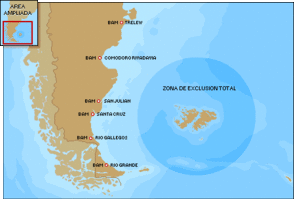
Because of the long distance to the islands, Argentine attack planes usually had only about two minutes to hit their targets.
Air units moved from their usual bases to facilities in the south of Argentina. To protect against British or Chilean air strikes and SAS raids, Argentine aircraft were spread out around their southern airfields. For example, parts of national route #3 were used to hide planes.
Here are some of the key airfields and what was based there:
- Ezeiza International Airport, Buenos Aires
- Boeing 707 transport planes
- NAS Almirante Zar, Trelew, Chubut Province
- B.Mk62 Canberra bombers
- AFB Comodoro Rivadavia, IX Air Brigade, Chubut Province (This was the main command center for the Southern Air Force)
- KC/C-130 Hercules transport and refueling planes
- Fokker F28 transport planes
- Escuadron Fenix civilian planes used for military tasks
- Mirage IIIEA fighter jets
- FMA IA 58 Pucará ground attack planes
- CIC Comodoro, an air traffic control center
- Airfield Puerto San Julián, Santa Cruz Province
- IAI Dagger jets - La Marinete Squadron
- A-4C Skyhawk attack jets
- Cardion AN/TPS-44 radar with GADA 601 Army anti-aircraft unit
- Airfield Puerto Santa Cruz, Santa Cruz Province
- A-4P Skyhawk attack jets
- AFB Rio Gallegos, Santa Cruz Province
- Mirage IIIEA fighter jets
- A-4P Skyhawk attack jets
- FMA IA 58 Pucará ground attack planes
- Navy Exploration Squadron (after May 13): S-2E Trackers and 2 leased Brazilian Air Force EMB111 Bandeirantes (2-P-201 & 2-P-202)
- CIC Gallegos, an air traffic control center
- NAS Almirante Quijada, Río Grande, Tierra del Fuego
- IAI Dagger jets - Las Avutardas Salvajes Squadron
- A-4Q Skyhawk attack jets
- Super Étendard jets
- SP-2H Neptune patrol planes
- AFB Puerto Argentino, Port Stanley Airport, Falkland Islands
- FMA IA 58 Pucará (Air Force)
- Aermacchi MB.339A (Navy)
- T-34 Mentor (Navy)
- Helicopters from all services
- CIC Malvinas, AN/TPS-43 radar and anti-aircraft defenses from all services
- AFB Condor, Goose Green grass airfield, Falkland Islands
- FMA IA 58 Pucará (Air Force)
- Anti-aircraft cannons (Air Force)
- NAS Calderon, Pebble Island grass airfield, Falkland Islands
- FMA IA 58 Pucará (Air Force)
- T-34 Mentor (Navy)
- Short Skyvan (Coast Guard)
- Aircraft carrier ARA Veinticinco de Mayo, (April 2 to May 3)
- McDonnell Douglas A-4Q Skyhawk attack jets
- Grumman S-2E Tracker patrol planes
- Sikorsky S-61D-4 helicopters
Types of Aircraft Used by Argentina
The numbers in bold show how many aircraft were used in combat (not counting reserves). The numbers in (brackets) show how many aircraft were lost during the war.

Argentine Air Force
(Fuerza Aérea Argentina)
- 1st Air Brigade -
- Lockheed C-130H Hercules, 7 (1)
- Lockheed KC-130H Hercules Tanker 2
- Boeing 707-320C、 3
- Fokker F-28-1000C 、6
- Fokker F-27-400M、 12
- 2nd Air Brigade - English Electric B.62 Canberra、 8 (2)
- Grupo Aérofotográfico - Learjet 35A 2 (1)
- 3rd Air Brigade -
- Falkland Islands - FMA IA 58A Pucará 24 (13)
- Comodoro Rivadavia - FMA IA 58A Pucará 1 (1)
- 4th Air Brigade - McDonnell Douglas A-4C Skyhawk 16 (9)
- 5th Air Brigade - McDonnell Douglas A-4B Skyhawk 30 (10)
- 6th Air Brigade - Israel Aircraft Industries Dagger 27 (11)
- 7th Air Brigade -
- Lockheed C-130E Hercules, 3
- Boeing CH-47C Chinook 2
- Bell 212 2
- 8th Air Brigade
- Dassault Mirage IIIEA 16 (2)
- DHC-6-200 1
(Comando de Aviación Naval Argentina - COAN) (Argentine Naval Aviation)
- 1st Naval Air Attack Squadron - Aermacchi MB.339A 6 (2)
- 2nd Naval Air Fighter/Attack Squadron - Dassault Super Étendard 4 (one plane, sn. 3-A-201, was taken apart for spare parts)
- 3rd Naval Air Fighter/Attack Squadron - McDonnell Douglas A-4Q Skyhawk 8 (3)
- Naval Air Antisubmarine Squadron - Grumman S-2E Tracker 6
- Naval Air Training Squadron - Beechcraft T-34C-1 Turbo Mentor 4 (4)
- Naval Air Exploration Squadron - Lockheed SP-2H Neptune 2 (both were retired by the end of May due to wear and tear)
- 1st Naval Air Helicopter Squadron -
- Aérospatiale Alouette AI03 SA361B 10 (1)
- Lynx Mk.23 2 (1)
- Britten-Norman BN-2A Islander 1
- 2nd Naval Air Helicopter Squadron - Sikorsky S-61D-4 5
- Naval Air Transport Squadrons -
- Lockheed L-188PF Electra 3
- Fokker F-28-3000C 3
- P-95 Bandeirulha 2
Argentine Army
(Comando de Aviación del Ejército Argentino) (Argentine Army Aviation)
- 601 Army Aviation Battalion -
- Boeing CH-47C Chinook 2 (1)
- Agusta A109A 3 (1)
- Bell UH-1H Iroquois 9
- Aérospatiale Puma SA330L 5 (5).
- South Georgia April 3 - Aérospatiale Puma SA330L 1 (1)
Argentine Coast Guard
(Prefectura Naval Argentina)
- Aviation Service -
- Aérospatiale Puma SA330L 1
- Short Skyvan 3M-200 5 (2)
Argentine Auxiliary Aircraft
- Escuadrón Fénix — 77 civilian business planes were used for military tasks.
- Aerolíneas Argentinas and Austral airlines:
- Boeing 737-200 2
- BAC 1-11-515FB 1 (used to fly supplies and people to Patagonia and Port Stanley).
Weapons Used by Argentine Aircraft
- Machine guns and cannons:
- 7.62 mm FM M2-20: Used on Pucaras
- 20 mm Colt Mk.12 Cannon: Used on A-4s
- 20 mm Hispano-Suiza HS.804 Cannon: Used on Pucaras
- 30 mm DEFA cannon: Used on IAI Daggers and Mirage IIIEA
- Unguided rockets:
- ZUNI 127 mm: Used on MB.339s
- 70 mm: Used on MB339s
- 105 mm: Used on Pucaras
- Missiles:
- Air-to-Air:
- AIM-9B Sidewinder (short-range, heat-seeking): Only on Navy A-4Q Skyhawks until May 1.
- Rafael Shafrir 2 (short-range, heat-seeking): Used on IAI Daggers and A-4C on May 1.
- Matra R550 Magic (short-range, heat-seeking): Received April 15 for Mirage IIIEA.
- Matra R530 (short-range, radar and heat-seeking): Used on Mirage IIIEA.
- Air-to-Surface:
- Aérospatiale AM.39 Exocet Anti-Ship Missile: 5 units used on Super Etendards.
- AS 30 air-surface missiles: Supplied by the Peruvian Air Force and arrived at the Tandil AFB (home of the FAA Dagger) at the end of May. The war ended before they could be used.
- Air-to-Air:
- Unguided bombs: Many bombs hit British ships but didn't explode. This was because they were dropped from very low altitudes, and there wasn't enough time for them to arm themselves before impact. This problem was fixed by June with new fuses bought from Spain.
- US-built Mark 82 Snake Eye (500 lb / 227 kg): Used on A-4Q.
- British-built "1000 lb" (450 kg): Used on A-4B/C, IAI Daggers, and Canberras.
- Spain-built Expal BR/BRP 250 kg: Used on A-4B/C and IAI Daggers.
- Argentine-built PG 125 kg: Used on Pucaras.
- Napalm: Used on Pucaras.
The Air Campaign: Missions and Results
Types of Missions Flown
| System | What they did |
|---|---|
| A-4 Skyhawk | The A-4B flew 133 attack missions, and the A-4C flew 86. Their ejection seats were not reliable due to a US ban from 1977. Naval A-4Q planes flew 12 missions. These planes relied heavily on the two KC-130 refueling tankers, which limited how many could attack at the same time. |
| Canberra | Flew 46 bombing missions against ground targets. They operated from Trelew to avoid making the closer southern airfields too busy. |
| Dagger | The two Dagger squadrons flew 153 missions against ships and ground targets. They couldn't refuel in the air, which greatly limited their ability to fly over the islands. They had to fly the shortest path and had less than 10 minutes to find their targets. When the British found out their flight path, 7 Daggers were shot down by Sea Harriers. By the end of May, they started using simple chaff (aluminum strips) from their airbrakes to confuse radars. |
| Total Attack Missions: | In total, there were 430 attack missions from the mainland. 18 aircraft were stopped by Sea Harriers, and another 14 were shot down by anti-aircraft defenses. |
Other Important Missions
| System | What they did |
|---|---|
| Mirage IIIEA | Some were kept back to protect the mainland from Vulcan attacks. However, they flew 58 missions to distract British forces, especially during the successful June 8 attacks on British landing ships. They had less fuel than the Daggers, so they couldn't be used as escorts. |
| Boeing 707 | These unarmed airliners flew 54 cargo flights and 61 reconnaissance and surveillance missions against the British Task Force. They first found the British fleet on April 21. On May 22, a Sea Harrier tried to stop a 707, making it retreat. Another 707 avoided 4 Sea Dart missiles. After that, 707s stopped trying to find the Task Force because it was too risky. On one occasion, a 707 met a British Nimrod by chance; both unarmed planes simply looked at each other and continued their missions. |
| Embraer P-95 Bandeirulha | Two of these planes joined the naval aviation on May 21. They flew 39 sea patrol missions from Rio Gallegos airbase. They were returned to the Brazilian air force on June 24. |
| IA 58 Pucará | They flew scouting and ground attack missions from airfields in the Falklands. They also patrolled the Patagonian coast from bases in Southern Argentina. Most Pucarás on the islands were destroyed on the ground by special forces. One Pucará shot down a Royal Marines Westland Scout helicopter during the battle of Goose Green. |
| Fenix Squadron | Flew 126 distraction missions and 52 scouting missions. They were also used a lot to relay communications and guide combat jets using the Learjets' better navigation systems. |
| C-130 Hercules | Flew 33 night flights to BAM Puerto Argentino (Port Stanley Airport) in May/June, acting as "blockade runners" to get supplies in. They carried things like Army commandos, large cannons, a homemade land-based Exocet launcher, the Roland SAM system, and a replacement radar. On their return flights, they evacuated 263 wounded soldiers and one British PoW. Starting May 15, they also took on the dangerous job of searching for ships for the attack units, after the last SP-2H Neptune was retired. On one of these daytime missions, a Hercules was stopped and shot down by a Sea Harrier. On May 29, the British tanker British Wye was hit by bombs dropped by a Hercules north of South Georgia (this is not officially recognized by the FAA). |
| KC-130 Hercules | Flew refueling missions for A-4s and Super Étendards, and also for damaged fighter planes. |
| Fokker F-28 (Navy) | Flew 15 night flights to BAM Puerto Argentino in May/June, also acting as "blockade runners." |
| Army Aviation | Flew 796 helicopter flights on the islands. |
| 1st Air Brigade Construction Group (Air Force) | This group was in charge of keeping Port Stanley airbase working. During the conflict, the airport was attacked with 237 bombs, 1,200 shells from Royal Navy ships, and 16 missiles. However, it was never completely out of action. Many sources claim that the runway was covered with dirt piles during the day to make it look damaged. In reality, the British knew the runway was still being used by C-130s and tried to stop these flights, which led to the loss of a C-130 on June 1. |
Successes of Argentine Air Forces
| What happened | Details |
|---|---|
| Ships Sunk | HMS Sheffield, HMS Coventry, HMS Ardent, HMS Antelope, RFA Sir Galahad, Atlantic Conveyor plus a Landing Craft Utility ("Foxtrot Four" from Fearless) |
| Ships Damaged | HMS Glasgow, HMS Antrim, HMS Brilliant, HMS Broadsword, HMS Alacrity, HMS Arrow, HMS Argonaut, HMS Plymouth, RFA Sir Bedivere, RFA Sir Lancelot, RFA Sir Tristram, RFA Stromness |
Losses and Casualties
- Human losses
- 6 from Argentine Army Aviation
- 4 from Argentine Naval Aviation
- 55 Argentine Air Force members
- 29 pilots
- 12 air crew (6 on a C-130H shot down June 1, 4 on a Learjet LJ-35A shot down June 7, and 2 Canberra navigators)
- 14 Ground crew
- Aircraft losses
- Aircraft lost in the air during combat
Argentine attack planes did not carry air-to-air missiles, except for 8th Air Brigade Mirage IIIEA fighters and 6th Air Brigade Daggers on May 1. All of them had cannons (20 mm or 30 mm) as a secondary weapon.
| 11 | IAI Dagger A | 9 by Sea Harrier, 1 by Sea Wolf missile from HMS Broadsword, 1 by SAM Rapier |
| 10 | A-4B Skyhawk | 3 by Sea Harrier, 3 by Sea Wolf from HMS Brilliant, 1 by Sea Dart, 1 by AAA (anti-aircraft artillery) from HMS Fearless, 1 by 20mm cannon fire from HMS Antelope and 1 by friendly fire |
| 7 | A-4C Skyhawk | 2 by Sea Harrier, 3 by Sea Dart, 1 by SeaCat from HMS Yarmouth, 1 by a combination of SeaCat/Rapier/Blowpipe |
| 3 | FMA IA 58 Pucará | 1 by Sea Harrier, 1 by SAM Stinger, 1 by small arms fire from 2 PARA (Parachute Regiment) |
| 3 | A-4Q Skyhawk (Navy) | 3 by Sea Harrier. |
| 2 | Mirage IIIEA | 1 by Sea Harrier, 1 by friendly fire |
| 2 | B.Mk62 Canberra | 1 by Sea Harrier, 1 by Sea Dart |
| 1 | C-130E Hercules | 1 by Sea Harrier |
| 1 | Aermacchi MB.339A (Navy) | 1 by Blowpipe |
| 1 | Learjet 35A | 1 by SAM Sea Dart |
| 4 | Puma SA330L (Army) | 1 by gun fire, 1 by SAM Sea Dart, 1 by FIM-92 Stinger, 1 by Royal Marines gun fire in South Georgia on April 3 |
Total destroyed in the air: 45 (21 by Sea Harrier, 7 by Sea Dart, 4 by Sea Wolf, 2 by Stinger, 1 by Sea Cat, 1 by Rapier, 1 by Blowpipe, 6 by combination/gunfire, 2 by friendly fire).
- Aircraft lost by other reasons
- Destroyed on the ground
- 9 FMA IA 58 Pucará
- 1 Agusta A109 (Army)
- 1 Boeing Ch-47C Chinook (Army)
- 2 Aérospatiale Puma SA330L (Army)
- 4 Beechcraft T-34 Mentor (Navy)
- 2 Skyvan 3-M (Coast Guard)
- 2 Bell UH-1H Iroquois (Army)
- Captured after the war
- 11 FMA IA 58 Pucará
- 2 Agusta A109 (Army)
- 7 Bell UH-1H Iroquois (Army)
- 1 Boeing CH-47C Chinook (Army)
- 1 Aérospatiale Puma SA330L (Coast Guard)
- 3 Aermacchi MB.339A (Navy)
- 2 Bell 212
- Lost with ARA General Belgrano
- 1 Aérospatiale Alouette AI03 (Navy)
- Flying accidents in the war zone
- 1 Westland Lynx HAS.Mk.23 (Navy) — May 2, hit ARA Santísima Trinidad
- 2 FMA IA 58 Pucará — May 28, hit ground (one recovered in 1986), May 24.
- 1 Aermacchi MB.339A (Navy) — May 3, crashed in bad weather
- 2 McDonnell Douglas A-4C Skyhawk — May 9, South Jason Island
Total lost by other causes: 55.
- Total aircraft losses
75 fixed-wing aircraft and 25 helicopters.
Images for kids
See Also


